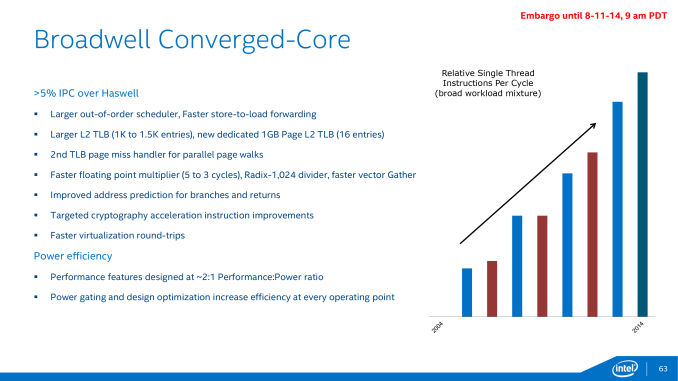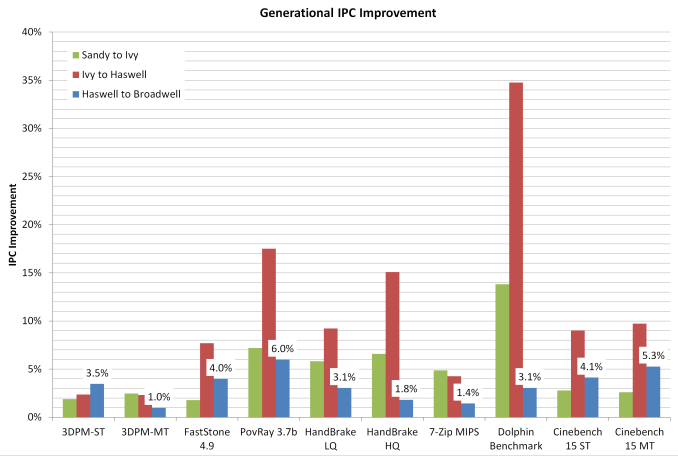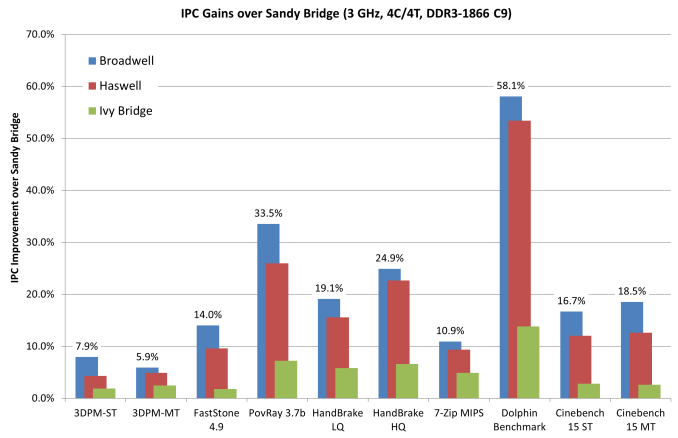The Intel Broadwell Review Part 2: Overclocking, IPC and Generational Analysis
by Ian Cutress on August 3, 2015 8:00 AM ESTConclusions: Broadwell Overclocking, IPC and Generational Gain
For everyone who has been in the PC industry for a decade or more, several key moments stand out when it comes to a better processor in the market. The Core architecture made leaps and bounds over the previous Pentium 4 Prescott debacle, primarily due to a refocus on efficiency over raw frequency. The Sandy Bridge architecture also came with a significant boost, moving the Northbridge on die and simplifying design.
Since then, despite the perseverance of (or soon to be mildly delayed) Moore’s Law, performance is measured differently. Efficiency, core count, integrated SIMD graphics, heterogeneous system architecture and specific instruction sets are now used due to the ever expanding and changing paradigm of user experience. Something that is fast for both compute and graphics, and then also uses near-zero power is the holy-grail in design. But let’s snap back to reality here – software is still designed in code one line at a time. The rate at which those lines are processed, particularly in response driven scenarios, is paramount. This is why the ‘instructions per clock/cycle’ metric, IPC, is still an important aspect of modern day computing.
As the movement from Haswell to Broadwell is a reduction in the lithography node, from 22nm to 14nm, with a few silicon changes, Broadwell was a mobile first design and launched in late 2014 with notebook parts. This is typical with node reductions due to the focus on efficiency overall rather than just performance. For the desktop parts, launched over six months later, we end up with an integrated graphics focused implementation purposefully designed for all-in-one PCs and integrated systems rather than a mainstream, high end processor. The i7 and i5 are both targeted at 65W, rather than 84W/88W of the previous architecture. This gives the CPUs a much lower frequency and without a corresponding IPC change, makes the upgrade path more focused for low end Haswell owners, those who are still several generations behind wanting an upgrade or those who specifically want an integrated graphics solution.
In our first look at Broadwell on the desktop, our recommendation that it would only appeal to those who need the best integrated graphics solution regardless of cost still stands. Part 2 has revealed that clock-for-clock, Broadwell gives 3.3% better performance from our tests although DRAM focused workloads (WinRAR) can benefit up to 25%, although those are few and far between. If we compare it back several generations, that small IPC gain is wiped out by processors like the i7-4790K that overpower the CPU performance in pure frequency or even the i7-4770K which still has a frequency advantage. From an overall CPU performance standpoint out of the box, the i7-5775C sits toe-to-toe with the i7-4770K with an average 1% loss. However, moving the comparison up to the i7-4790K and due to that frequency difference, the Broadwell CPU sits an average 12% behind it, except in those specific tests that can use the eDRAM.
There’s nothing much to be gained with overclocking either. Our i7-5775C CPU made 4.2 GHz, in line with Intel’s expectations for these processors. If we compare that to an overclocked 4.6 GHz i7-4790K, the 4790K is still the winner. Overclocking on these Broadwell CPUs still requires care, due to the arrangement of the CPU under the heatspreader with the added DRAM. We suggest the line method of thermal paste application rather than the large-pea method as a result.
Looking back on the generational improvements since Sandy Bridge is actually rather interesting. I remember using the i7-2600K, overclocking it to 5.0 GHz and remembering how stunned I was at the time. Step forward 4.5 years and we have a direct 21% increase in raw performance per clock, along with the added functionality benefits of faster memory and a chipset that offers a lot more functionality. If you’ve been following the technology industry lately, there is plenty of talk surrounding the upcoming launch of Skylake, an architectural update to Intel’s processor line on 14nm. I can’t wait to see how that performs in relation to the four generations tested in this article.
*When this article was initially published, inaccuracies were made in calculating the IPC gain in the timed benchmarks. The article has been updated to reflect this change. In light of the recalculation,overall conclusions are still correct.
Interesting related links:
The Intel Broadwell Desktop Review: Core i7-5775C and Core i5-5675C Tested (Part 1)
AnandTech Bench CPU Comparison Tool














121 Comments
View All Comments
extide - Monday, August 3, 2015 - link
Actually, no the Author has it correct. The big die the che CPU/GPU, and the small one is the eDRAM.On the GT3 dies, Intel folds the graphics back across the CPU's, instead of having it as a very long rectangle.
See this: http://www.computershopper.com/var/ezwebin_site/st...
vs This: http://www.overclock.net/content/type/61/id/230657...
hansmuff - Monday, August 3, 2015 - link
Ian, Thank you for this excellent article. I have wished for a 2600k comparison to the more recent CPU iterations and one can piece some of it together here and there but this comprehensive view is outstanding! Still holding out for Skylake, then the 2600k might have to retire.Ewann - Monday, August 3, 2015 - link
I am really happy to see the i7-2600k comparison here. Like others who've commented, I'm still running that CPU- albeit at stock clock- and it's been totally stable with months on end of uptime (knock on wood). Sure, I've upgraded the GPU once or twice since 2011, but I can't see any reason to build a new system based on these benchmarks. The GPU (GTX 780) is still the limiting factor for gaming, and the 15-20% performance boost overall won't make a significant difference in my day-to-day usage. I now understand why Intel is struggling.Awesomeness - Monday, August 3, 2015 - link
Same here. I bought a 2600K in the first month it was out. After years of 24/7 operation at 4,9GHz it died. I replaced it with a $100 2500K that's running at 4,6GHz. SB for the win.nathanddrews - Monday, August 3, 2015 - link
OC benchmarks from each generation? I saw stock benchmarks and 3GHz benchmarks, but not benchmarks for Good or Great OC. I was expecting it based off of the title, but didn't see anything in the article.Staafk - Monday, August 3, 2015 - link
Missing OC performance comparisons. Or am I blind? The latter is quite possible tbh.Dribble - Monday, August 3, 2015 - link
Yes, that's what I thought. I want to see what they can all do at a good o/c. I don't run my cpu stock or at 3ghz, I want to see how my o/c sandy bridge would do against an o/c broadwell to see if it's worth an upgrade yet?Impulses - Monday, August 3, 2015 - link
You can typically extrapolate like 5% per 200MHz, tho it would've been nice to see indeed.joex4444 - Monday, August 3, 2015 - link
With the whole point of the article being that IPC goes up, this rule is really not suitable. If the IPC goes up by 20%, then if the previous generation followed the 5% per 200MHz rule the new generation follows either 6% per 200MHz or 5% per 167MHz. Though we'd really expect the instructions per second (IPS) to be the important part, and that's not dependent solely upon the size of the overclock, but the ratio of the overclock to stock. Jumping to 4.2GHz from 3.2GHz is a 31% gain, but going to 4.5GHz from 3.5GHz is a 29% gain despite both being a 1.0GHz overclock.With the typical IPC gain of 4.4%, we could roughly estimate that a Broadwell at 4.2GHz is like a Haswell at 4.4GHz. With 4.2GHz on Broadwell being a "Good OC" and 4.5GHz on Haswell being a "Good OC" we'd still expect Haswell to be faster once overclocked - but the review should be showing this. However if the particular program is making really good use of the eDRAM, then that 4.2GHz is akin to Haswell at 4.9GHz, which is beyond an excellent OC...
SirMaster - Monday, August 3, 2015 - link
Feelin' pretty good about my 4.6GHz 4770K that I bought more than 2 years ago heh.